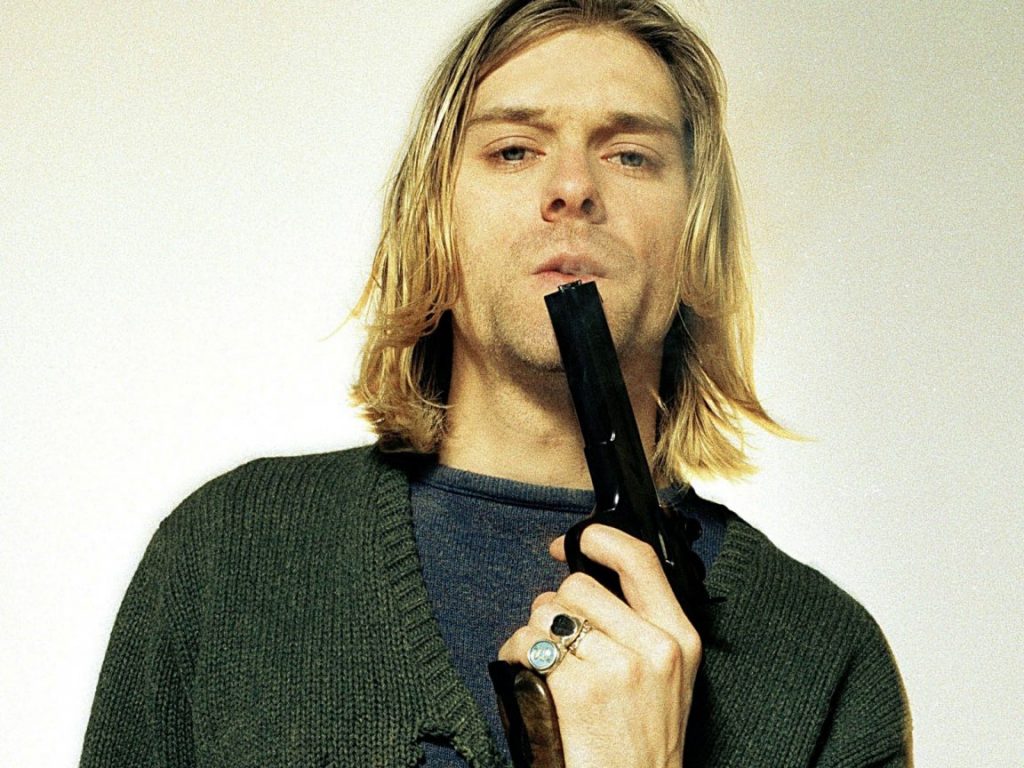“I’m not afraid of dying. Total peace after death, becoming someone else is the best hope I’ve got.” This statement made by Nirvana front-man Kurt Cobain reflects both the self-loathing and general sorrow, or anguish, that he felt he was constantly suffering from and ultimately what led to the tragic event that occurred on April 5, 1994. Kurt Cobain, the lead singer of the band Nirvana, was born in Hoaquiam, Washington on February 20, 1967.1 Few honestly know of the struggles Kurt had to endure in his life, such as his parents’ divorce when he was about nine. This break-up resulted in Kurt losing a permanent place of residence, leaving him in a constant state of borderline homelessness. As a matter of fact, Kurt even resorted to staying at the hospital where he was born around the age of nineteen.2 Regardless, Kurt still managed to climb from rock bottom to become the star he was: the lead singer of Nirvana and the face of grunge music for many people worldwide.

Of course, Nirvana didn’t come straight out the gate making hits nor score international shows. The band Nirvana actually had quite a macabre or fuzzy rise in comparison to other bands. Interestingly enough, Nirvana didn’t even start off being called Nirvana. This small trio actually bounced around with abstract names for quite a few years. From their humble beginnings in Aberdeen, Washington, in 1987 the band was known as Skid Row, Pen Cap Chew, and Bliss all within the same year.3 They played a few house parties and even fewer shows at real venues around the Aberdeen area, but the band life was more of a hobby to the group. They had fun doing what they did, played their hearts out when they had to, but they didn’t really think they were going to be anything huge when they first started out.
The group may have started small, but the effort and time they put into the band would soon enough pay off. In 1989, they released their independent album Bleach, which got them a lot more shows in lots of new places. The band finally started “blowing up” and gathering many followers nationwide. With this newfound momentum, Nirvana signed with Geffen Records and released their second album Nevermind, which has since become legendary. This was just two years after their first independent album Bleach was released.4 Nevermind kicked off Nirvana’s international rise to a new high, scoring them not only shows around the country, but in other countries as well. Nirvana went global and this new, dissonant, and muddy type of rock music started receiving mainstream recognition. This new and quickly popular genre became known and recognized as grunge, a form of punk rock with the muddy sounds of post-punk mixed with a sprinkle of youthful angst.5 This new genre became the sound of the ’90’s, with many bands such as Soundgarden, Pearl Jam, and Alice in Chains riding the wave. But for many worldwide, songs such as “Smells Like Teen Spirit” or most of the songs from Nirvana’s Nevermind album became grunge anthems that depicted the youthful rebellion and dissonance reflected in grunge music.6

Although Nirvana was finally blowing up and rising to international fame quickly, the lead singer Kurt Cobain was still not truly satisfied with his life. Throughout his life, Cobain constantly suffered from stomach illnesses. In response to this constant illness, Kobain would abuse drugs like heroin, claiming it would cure this problem. Even worse, when Kurt met his soon to be mother of his child Kourtney Love, his heroin abuse only got worse.7 With more money and fame, his addiction grew stronger and the pressures of fame and fortune began mounting on his shoulders, until one day it was just too much. In 1994, while on tour in Europe, Kurt had to be hospitalized for drug overdose and other health issues including alcohol problems. Soon after, he was forced to cancel the tour and return back home to Seattle. His family and friends decided to stage an intervention and convince him to admit himself into rehab, much to his displeasure. This rehabilitation did not last long, as Kurt decided to flee the rehab center and return back home to Seattle, tragically unbeknownst to his family and friends. On April 8, 1994, an electrician found Kurt Cobain’s dead body in a room above the garage above his home where he was hiding out at.8 The cause of death was a self-inflicted shotgun blast to the head, and even worse, heroin was found in his system so it’s not even clear if Cobain really meant to do that to himself or if the drugs influenced him to do so.9
Cobain’s inconceivable and unanticipated death resulted in worldwide mourning over the loss of this young artist’s life. Family and friends, especially his girlfriend and daughter, were heavily affected by this tragedy, as well as all of his listeners. Cobain was an icon for Generation X. He gave voice to the youthful generation of people that felt they were dealt a bad hand. He encouraged the generation, and became “the poster boy for grunge.” After Kurt’s death, the grunge scene died down quickly. Of course, there were still other bands in the genre putting out a few successful albums, but the genre never saw the fame and glory it had during its heyday in the early ’90’s, when Nirvana was contributing to the movement.10 The genre died out as quickly as it was born, with the untimely and very unfortunate death of a very talented and tormented young artist.
- Salem Press Biographical Encyclopedia, 2013, s.v. “Kurt Cobain,” by Delbert S. Bowers. ↵
- Nick Soulsby, I Found My Friends: The Oral History of Nirvana (New York : Thomas Dunne Books/St. Martin’s Griffin, 2015). 7. ↵
- Salem Press Encyclopedia, 2013, s.v. “Nirvana (music),” by Alan Haslam; Nick Soulsby, I Found My Friends: The Oral History of Nirvana (New York : Thomas Dunne Books/St. Martin’s Griffin, 2015), 1-18. ↵
- Salem Press Encyclopedia, 2013, s.v. “Nirvana (music),” by Alan Haslam. ↵
- Baker’s Biographical Dictionary of Popular Musicians, 2004, s.v. “Grunge: A Brief History of a Hard Rock Genre,” by Gil Kaufman. ↵
- Baker’s Biographical Dictionary of Popular Musicians, 2004, s.v. “Grunge: A Brief History of a Hard Rock Genre,” by Gil Kaufman. ↵
- Salem Press Biographical Encyclopedia, 2013, s.v. “Kurt Cobain,” by Delbert S. Bowers. ↵
- Salem Press Biographical Encyclopedia, 2013, s.v. “Kurt Cobain,” by Delbert S. Bowers. ↵
- Salem Press Encyclopedia, 2013, s.v. “Nirvana (music),” by Alan Haslam. ↵
- Baker’s Biographical Dictionary of Popular Musicians, 2004, s.v. “Grunge: A Brief History of a Hard Rock Genre,” by Gil Kaufman. ↵



112 comments
Brandon
I dont see how you said other bands rode the wave with few successful albums every album Alice in Chains put out went platinum also Pearl Jam also had major success, my opinion i love some of nirvana songs as well as Cobain but Alice in Chains was by far better and Layne Staley was a far better singer….
Emily Velazquez
This article was very interesting and a smooth read. I enjoyed reading about Kurt Cobain because there is always so much that artists go through to get to where they are. Kurt battled a constant stomach disease that he said he would treat with heroin. I feel as if it is always a similar process that artists go through. There is so much pressure from the fame, fortune, and just life on every artist’s shoulders and it often becomes too much to handle for them so they resort to other things that help relieve the pressure.
Thomas Fraire
Kurt Cobain is an icon that legacy lives on today, even famous people love him. I love the things he put out in his time it revolutionized and helped shape music into what it is today. I really enjoyed this article it is tragic he took his life despite all his success. But I am glad he has not been forgotten. It is just sad no one saw it coming and one day he was here and the next he was gone it seems to happen with alot of our legendary celebrities
Danniella Villarreal
It’s sad to know that people like Kurt go through so much in their life that cause them to give up. It is nice to read the background of an artist just to be able to appreciate music in a better way. This article helped me learn how unhappy Cobain actually was, and how his heroin addiction coupled to it led to his demise. Overall a very well written and informative article, I enjoyed reading it.
Gary
Im no CT but there is still no way with the amount of heroin in his system, that he took his own life or would even be able to injest that much of the drug before being unconscious. facts is facts even all these years later. No way.
Vanessa Sanchez
This article is a very interesting one to read about an Artist’s struggles and how it came to an end. Kurt Cobain from Nirvana til this day, is still iconic, life or death. Nirvana is a popular
band in the grunge music. Had many hits in the 1990s and some songs are even famous til this day. This article basically sums up about his life, how his parents went through a divorce and almost his whole childhood, he was borderline homeless mostly all the time to the point where he had to resort to stay in a hospital just to have a bed.Kurt had suffered many mental and physical illness to the point where he took his own life. This just bring me different perspectives on everything. Overall, this article was very well written, well structures and the article was very interesting to read.
Octaviano Huron
Kurt Cobain is tragically one of many musical icons gone too soon. It is sad that drug abuse had taken over his life, as it does for countless lives around the world. As a person who has listened to Nirvana’s music, I believe that their sound and legacy is truly unique. This band was a musical icon, and continues to be a defining characteristic of 90s culture. Thank you for this interesting article.
Trey
Kurt didn’t have an alcohol problem, his stomach condition wouldn’t allow it.
Ryan Estes
Reflecting on this article, it can be very hard for people who long to be famous and are successful. For example, let’s just say someone wanted to be a singer ever since they were a little kid. They have an amazing voice, and their family, friends, and teachers encourage them to keep singing. Eventually, they get recognized by record labels and become famous as time goes on. It’s unfortunate that fame makes people feel like they have to do drugs. The pressure from performing well accumulates, and unfortunately the stars we love give in. I wish it wasn’t this way, but I think more of a focus needs to go to therapeutic treatment for the exalted among us. That way, they know they are not alone and the world wants to continue hearing their music, reading their books, etc. for years to come.
Aracely Ortiz Soriano
I feel like a lot of good art and music is never the product of happiness, which is unfortunate but I feel this best depicts Kurt Cobain’s situation. I always like knowing an artist’s backgrounds to have a better appreciation of their music and through this article, I learned how unhappy Cobain actually was, and how his heroin addiction coupled to it led to his demise.